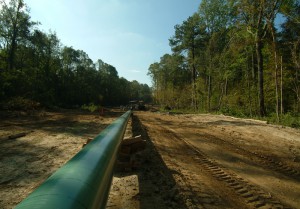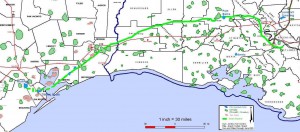September 2009 Vol. 236 No. 9
Features
Specialist Firm Offers An Integrated Approach to Wetlands Mitigation

“Can’t we set aside (pipeline construction) project land for mitigation of our future impacts?”
“Just how many acres of wetland impact does our project have?”
“Where’s a mitigation bank nearby — one that has credits available?”
“What process or workflow do we apply to determine our mitigation needs?”
“After working with our consulting engineering and environmental firms to use route changes and existing rights of way to avoid and minimize wetland impacts, what’s next?”
“How do we minimize the impact to our service schedule?”
These questions are from clients facing the challenge of mitigating potential environmental impacts in an era of growing volumes of regulation and increasingly aggressive project schedules. Pipeline companies, their owners, oil and gas operators and their supporting engineering and environmental consultants, regularly seek answers to these questions.
To appreciate the integrated approach to addressing these challenging questions, some background terminology is warranted. What is mitigation sequencing? Mitigation sequencing is a three-step process consistently mandated by regulatory agencies:
Step 1 – avoid impacts to regulated and/or other important resources;
Step 2 – minimize impacts to those resources that cannot be avoided; and,
Step 3 – mitigate impacts to those resources that cannot be further minimized.
Most intrastate and long-haul pipelines will likely have to document this process for regulatory agencies. Assuming that impacts will indeed occur, how does one best mitigate? A new solution has arisen from an integrated solution provider that serves the burgeoning, complex and often misunderstood marketplace for wetlands mitigation.
Final Rule
On June 9, 2008, the U.S. Army Corps of Engineers and the Environmental Protection Agency (EPA) made effective the Final Rule governing Compensatory Mitigation for Losses of Aquatic Resources (Federal Register pp. 19594-19705, 33 CPR Parts 325 and 332 and 40 CFR Part 230). It applies to activities authorized by permits issued by the Department of the Army under the Corps’ Clean Water Act (CWA) Regulatory Program. CWA permits of some sort are required for most pipeline projects in the U.S.
The Rule provides a foundation for addressing wetland impacts by pointing to mitigation banks as the preferred mitigation solution in any given watershed. The federal government is now further enabled to meet the longstanding goal of “no net loss” of wetland function while accommodating responsible construction and development that improves America’s infrastructure.
There is gap in supply of mitigation credits available today versus the current and future demand for credits. The process of developing mitigation banks is both complex and financially intense, thereby effectively limiting the number of successful players capable of timely credit delivery in this emerging market.
Integrated Solution
What is a pipeline or natural gas company to do to comply with these new regulations? Resource Environmental Solutions LLC (RES) has developed a total solution approach to address the needs of both sides of this mitigation credit supply-demand equation. RES is a mitigation bank developer based in Baton Rouge, LA with offices in Houston. It is backed by institutional investors (pension funds) and founded and operated by private equity investors. RES is a commercial entity with mitigation banking as its core business focus. It has built mitigation banks to generate mitigation credits that were subsequently sold to oil and gas companies, pipeline companies, other private enterprises and municipal, state and federal government entities. RES has built and applied custom mitigation impact workflows and delivered individually tailored, turnkey mitigation solutions for its clients.

Pipeline companies frequently face unique challenges with regard to mitigation. Projects frequently cross the boundaries of one or more watersheds (also known as hydrologic unit codes, or HUCS) and/or one or more of the Corps’ 38 regulatory districts. To further complicate a project, political boundaries can add complexity to the permitting and mitigation work efforts — crossing state, county/parish or municipal boundaries. Regulators call these “linear projects.”
The Corps, while systematic in its approach to permitting and mitigation as required by 33 CFR Parts 325 and 332, may assess the number of required credits for any given acre of project land using different methods in different locations or even different methods within the same geographic location – variability often due to ecosystem-specific issues.
The integrated solution approach by RES has addressed these geographically-diverse, multi-jurisdiction scenarios for a number of clients. First, recognition of the multidisciplinary nature of wetlands mitigation and restoration is required. The sciences of watershed management, forest management, civil and environmental engineering, geographic information systems (GIS), geomorphology, hydrology, botany, zoology, and wetland ecology are combined with expertise in environmental permitting and fiduciary responsibility to enable an integrated approach to mitigation problem solving.
Next, an analysis of client needs must recognize both short-term requirements–including budget and scheduling–and long-term project goals–which are considered by regulatory agencies in light of their need to require measurable, enforceable ecological performance standards for mitigation solutions. This disclosure and discussion step is key to the entire solution equation as here is forged a strong bond between the mitigation solution provider and the client needing compensatory mitigation to obtain the permit.
Development and application of a workflow where data is captured and analyzed is a fruitful step; resulting outputs are both visually informative and quantifiable for both parties. A financial model of the solution set may then be used to review scenarios considering available, released mitigation credits and their relative prices, the features of lands to be proactively acquired and the capital deployment needed for ongoing and future mitigation bank development and operations. The result of these activities is a fit-for-purpose solution where clients have control of their budgets yet are able to forecast their wetland impact credit needs so as to meet project timelines. The solution provider has clear marching orders and can then determine a financially- and environmentally-satisfying solution for all stakeholders: the client-applicant needing mitigation, the mitigation solution company and its investors, and the regulatory community – a win-win-win.
Case Study
The integrated solution approach was applied in the case of the “Green Pipeline” Louisiana leg for Denbury Resources.
Denbury’s carbon dioxide pipeline route includes right of way construction to facilitate the installation of a 24-inch pipeline a distance of 210 miles, west-to-east, across southern Louisiana. Denbury required a wetland mitigation solution to accommodate multiple watersheds with consideration for impacted travel corridors of a threatened species, the Louisiana Black Bear (consideration of federally protected species and state agency programs – here Louisiana Department of Wildlife and Fisheries – are additional components of the integrated mitigation solution and the subject of a separate article).

From site selection through Corps planning meetings, deployment of capital, initiation of wetland restoration and ultimately permit approval, RES delivered the complete, integrated solution in less than 100 days. The resulting Bayou Rouge Mitigation Area (BRMA) solution provided 537 acres of bottomland hardwood forest and 58.3 acres of baldcypress swamp by restoring surface hydrology, planting selected species of trees and herbaceous vegetation and providing effective and continuous hands-on management throughout the life of the BRMA. The restored forests and swamps provide protected travel corridors for the Louisiana Black Bear and will ultimately contribute to the successful recovery of that species.
In this case, RES delivered to Denbury an integrated solution that accelerated permitting and construction, provided access to permanent conservation easements, and utilized in-house resources to implement wetland mitigation in a price-sensitive manner.
The author:
Russell F. Krauss is Vice President, Business Development with Resource Environmental Solutions, LLC, in Houston. He has more than 24 years of experience developing new markets in technical, support, sales, marketing and management roles for technology products and services in the oil and gas industry with Marathon Oil, Digital Equipment Corporation, Cray Research, and Sun Microsystems. He holds a bachelor’s degree in geology from Boston University and a master of business administration degree from the Executive MBA Program at the University of Houston.





Comments